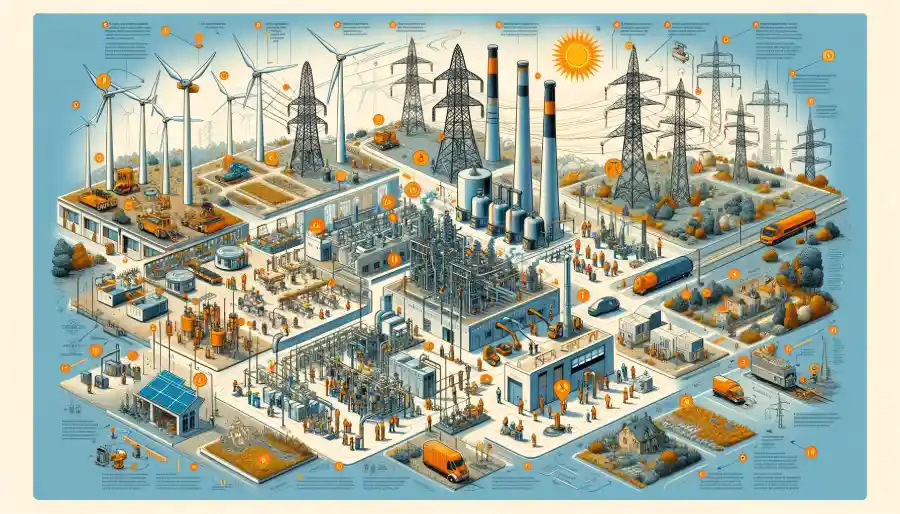Many people don’t give much thought to generating and delivering electricity until they flip a switch or do laundry. The process of passing along energy is complicated and involves a lot of people. It starts at a power plant where fuel sources like coal or natural gas are burned to produce electricity. That electricity is then sent to substations, lowered to a lower voltage, and distributed through the lines in your yard or on poles. In deregulated markets, electricity suppliers offer more choices for customers. They do not operate or own the electric distribution system but purchase electricity wholesale and supply it to customers at competitive utility prices.
Generating Plants
The power plants that supply electricity to consumers are at the heart of the nation’s electric grid. Engineers convert heat energy into mechanical work at these facilities using steam turbines that generate electricity. Today, more than 11,000 utility-scale electric generating facilities across the United States deliver electricity to homes and businesses through approximately 160,000 miles of high-voltage transmission lines. Power demand varies throughout the day and across regions with different population densities. To meet peak demand, electricity generation operators dispatch (release) power to the grid to match supply with customer needs. This process requires coordination between plant operators and transmission system operators. During the off-peak hours of the day, utilities can balance the load by sharing power from other sources in their interconnected systems. As the energy industry continues to evolve, various forces may impact the future management and operation of the electric grid. These include a shift from coal and fuel oil to natural gas, uncertainty about the long-term role of nuclear power, rapid deployment of intermittent renewables, changing load patterns, and growing interactions at Federal, State, and local levels. In the event of a disruption to the electric grid, the priority for repair is usually given to large transmission lines and substations as they simultaneously provide power to thousands of customers. This allows the rest of the grid to reroute or prioritize its resources for other essential services such as water, fire fighting, police and emergency services, transportation, manufacturing, and more.
Transmission Lines
Power must be transported from the power plant to the local distribution system or to other locations where it will be used. This bulk movement of electricity is called transmission. It involves electric power transmission lines at voltages of 230 kilovolts and higher, which are supported by towers and can be overhead or underground. High-voltage transmission is more efficient than low-voltage lines because it reduces energy loss due to wire resistance. This efficiency allows more of the generator’s output to be delivered to consumers. The Corpus Christi electric company supply chain varies across the state. Still, most retail customers buy their power from not-for-profit municipal electric utilities, member-owned cooperatives, private, for-profit electric utilities owned by stockholders (also known as investor-owned utilities), and a few government-owned utilities. Some utilities own their own generating plants, while others purchase from power marketers and independent power producers through the wholesale market organized by regional transmission reliability organizations. Because of the interconnected nature of transmission systems, all utility companies that sell electricity must agree to share transmission capacity during peak demand. This agreement is made through interconnection and overseen by entities called balancing authorities, ensuring that power supply matches power demand.
Substations
A substation is a vital component of power transmission and distribution systems. Its primary function is to change voltage levels for efficient power transmission, but it also performs various other tasks as needed. Generally, the heart of any substation is a large power transformer that steps up or down voltage for transmission purposes. Additional equipment may include buses, current and potential transformers, circuit breakers, switches and a lightning arrester. Power leaves a generating station and enters a transmission substation at its power plant location. The substation uses a series of large transformers to increase the power’s voltage for long-distance transmission on the electric grid, often over hundreds of miles. This step-up helps to reduce power loss due to resistance as electricity travels over such a long distance. The power then leaves the transmission substation and other utility assets and heads toward consumers via primary and secondary transmission lines. A secondary transmission substation along a second line will “step down” the voltage to a lower level suitable for distribution networks. Once the voltage is stepped down at this substation, it travels over medium-voltage feeder cables running overhead or underground (depending on local utility practices). A distribution substation then reduces the voltage to low levels for distribution to residential and commercial consumers in the service area.
Distribution Lines
Once electricity has been generated, it moves through a system of wires to reach homes and businesses. These lines called the grid, are a massive network of power stations, substations and distribution lines. It’s a remarkable system; you may already know the equipment that makes it all work. You can recognize transmission lines from the tall metal poles/towers, often on the side of highways. These move bulk electricity over long distances at high voltage levels (up to 500 kV). Power from transmission lines is then reduced, or “stepped down,” at substations before it moves to distribution lines that transport lower-voltage energy over shorter distances. Electricity from the distribution lines enters your home or business through a circuit breaker panel like this one and flows into outlets and light bulbs. Your energy provider will supply the electricity that flows through these lines, and your monthly bill will include both distribution and supply charges. If you live in a deregulated energy market, choosing whether to go with an electricity provider or a utility is up to you. Electricity providers serve as price and contract regulators between consumers and utilities, offering options you won’t find from a utility company alone.
